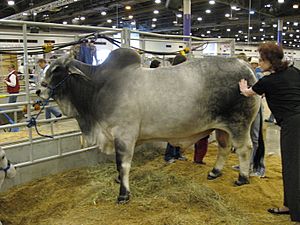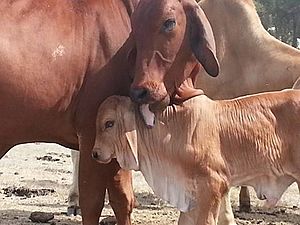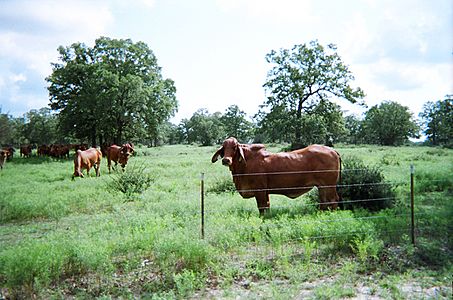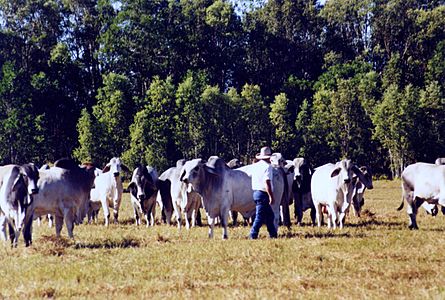American Brahman facts for kids
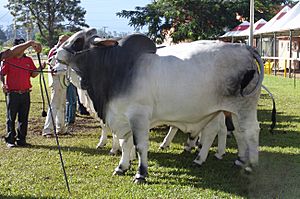
Bull in Avaré, Brazil
|
|
| Conservation status | FAO (2007): not at risk |
|---|---|
| Country of origin | United States |
| Distribution |
|
| Standard | American Brahman Breeders Association |
| Use | meat |
|
|
The Brahman is a special breed of beef cattle from the United States. It's a mix of different cattle types, especially those from India. This breed was created in the United States starting in 1885. The first cattle came from India, and some were imported through the United Kingdom and Brazil.
The main types of Indian cattle used to create the Brahman were Gir, Guzerá, and Nelore. Some Indu-Brasil, Krishna Valley, and Ongole cattle were also part of the mix. Brahmans are great at handling hot weather, bright sunlight, and humidity. They are also good at resisting parasites like ticks. This is why they are popular in many countries, especially in warm, tropical areas. In Australia, the Brahman is the most common cattle breed. This breed has also been used to create many other mixed breeds, like the Brangus and Brahmousin. These new breeds are now recognized on their own.
Contents
History of the Brahman Breed
Cattle from Asia, known for their humps (called Zebu cattle), first arrived in the United States in 1849. The very first one was a bull from India, brought from the United Kingdom to South Carolina. In 1885, two grey bulls came directly from India to Texas. One was very large, weighing over 800 kilograms (about 1,760 pounds). The other was about half that size.
Mixing these Indian bulls with local European-type cows was the first step in creating the Brahman breed. More small groups of Indian cattle were brought in until about 1906, mostly to Texas. Some of these cattle were even shown as circus animals before being sold to ranchers. In 1924 and 1925, a larger number of cattle from Brazil arrived in the United States through Mexico. These were mostly mixed Zebu and European cattle called Guzerá. There were also some Gir and Nelore cattle. In total, 210 bulls and 18 cows were imported.
A group called the American Brahman Breeders Association was started in 1924. They began keeping a special list, called a herd-book, to record all the Brahman cattle. The name "Brahman" was chosen by J. W. Sartwelle, who was the secretary of this group. In 1939, the herd-book was closed. After that, only calves born to registered Brahman parents could be added to the list. However, in 1946, eighteen imported Brazilian bulls were allowed to be registered. These were mainly Indu-Brasil and Gir cattle. Some other imported cattle were added later too.
The association recorded all American cattle of Indian origin in the same herd-book until 1991. Then, separate herd-books were made for Gir, Guzerat, Indu-Brasil, Nelore, and Tabapua cattle. The American Red and Grey Brahman breeds kept their own separate list.
Brahman cattle were first sent to Australia in 1933. Exports continued until 1954, with 49 cattle sent in total. By 1973, their offspring had grown to more than 225,000. Around 700 more Brahmans were imported after 1981. By 1987, there were over a million Brahmans in Queensland alone. By the end of the 1900s, there were more Brahmans in Australia than any other cattle breed, especially in the warm, northern parts of the country.
Special Traits of Brahmans
The Brahman breed is very good at handling heat. This is why they are found all over the world in tropical places. They also have thick skin, which helps them resist insects. Brahman cattle often live longer than many other breeds. They can even have calves when they are 15 years old or older!
How Brahmans Are Used
Brahmans are raised for their meat, especially in areas where it's hot or tropical. Like other Zebu cattle, their meat is sometimes not as tender as meat from European beef cattle breeds. Because of this, Brahmans are often mixed with those European breeds. This can be done by raising calves from purebred parents or by creating a completely new mixed breed.
Many new breeds have been created this way. Some, like the Brahmousin (a mix of Brahman and Limousin), Brangus (Brahman and Angus), and Simbrah (Brahman and Simmental), have become recognized as their own separate breeds. Other mixes include the Brahorn (Brahman and Shorthorn), Bravon (Brahman and Devon), and Bra-Swiss (Brahman and Brown Swiss).
In Oman and Fujairah, Brahman bulls are used in a traditional sport called bull-butting. In this sport, two bulls push their heads against each other. The first bull to step back or give up is the loser. Bulls being prepared for this sport are sometimes given a special diet of milk and honey to help them gain strength.
Gallery
-
Bulls in a paddock in the Northern Territory, Australia.
Images for kids
See also
 In Spanish: Brahman (raza bovina) para niños
In Spanish: Brahman (raza bovina) para niños


